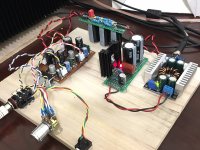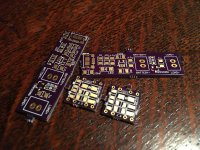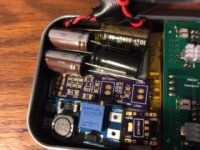Yeah, that's what I'm wondering about.You mean test 47uF vs 100uF relative to noise?
Hmm, I don't think it will affect noise from standpoint of a battery supply much as the purpose was to serve as a soft-start device. However, I have been making smaller cap multipliers using IRF610's like the one here for my latest amp under development. This is the Quasi-69, a quasi-complimentary design with a Rush cascode front end and identical N-channel MOSFET output stages, with a selectable behavior of operating in SE Class A mode vs push-pull Class A mode, and ability to go to Class AB when more power is needed. The circuit was inspired from the DLH amp in this thread:
DLH Amplifier: The trilogy with PLH and JLH amps
In a collaboration with Aksa, I have built a prototype in all SMT (except or electrolytic caps) and it is quite compact, almost as small as the PCA, not including power supply - which could be two 9v batteries.
Closeup of stereo amp in SMT:

With PSU and cap multiplier (the black heatsink in middle) and DC step up:
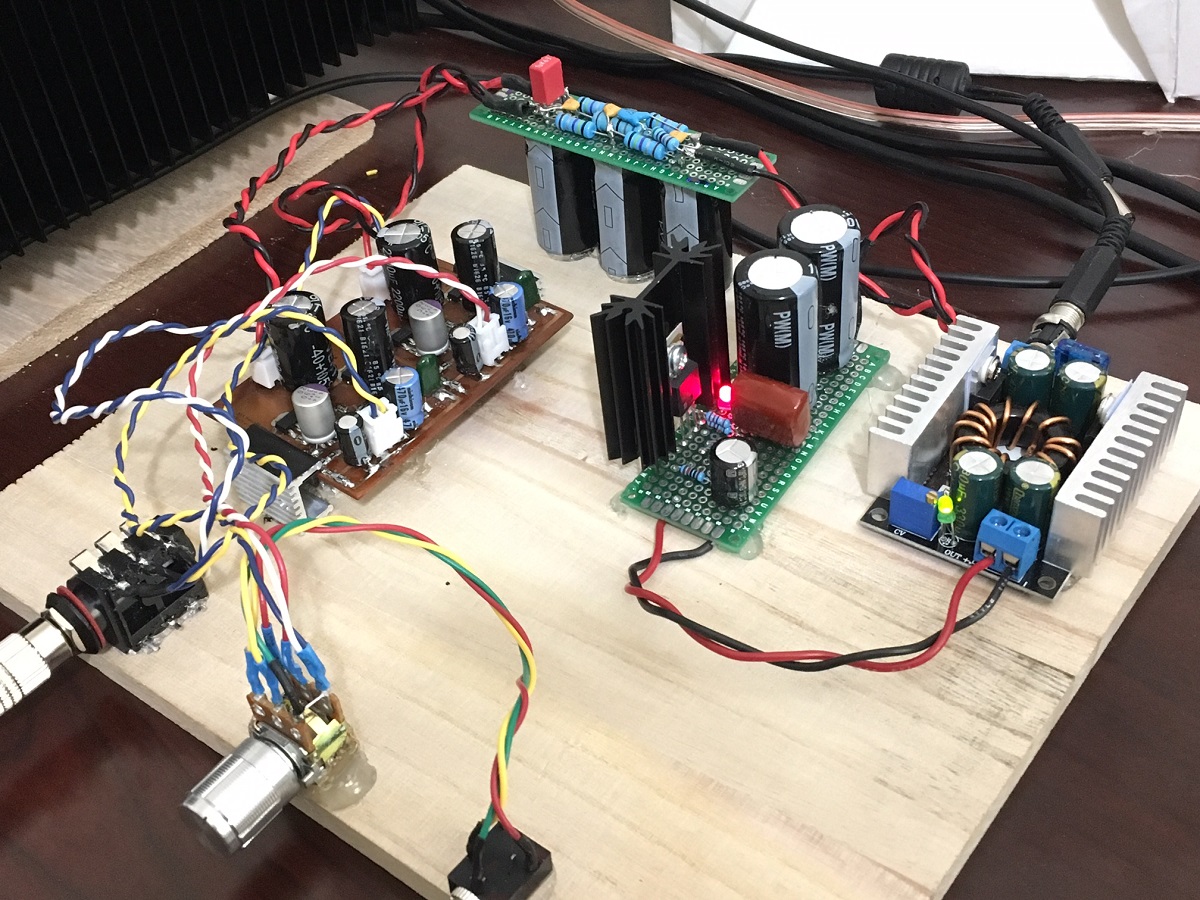
DLH Amplifier: The trilogy with PLH and JLH amps
In a collaboration with Aksa, I have built a prototype in all SMT (except or electrolytic caps) and it is quite compact, almost as small as the PCA, not including power supply - which could be two 9v batteries.
Closeup of stereo amp in SMT:
With PSU and cap multiplier (the black heatsink in middle) and DC step up:
Attachments
Here is the 25V 47uF 1210 ceramic cap for the RL mod.
TMK325ABJ476MM-P Taiyo Yuden | Capacitors | DigiKey
TMK325ABJ476MM-P Taiyo Yuden | Capacitors | DigiKey
Background:
One person's observations on three different class A headphone amps and six different manufactures headphones. The listening observations were made over a period of several days. At age 65 with mild tinnitus and definite high frequency hearing loss these observations should be taken with these facts in mind.
The class A headphone amps are the diy Pass Headphone amp by Wayne (wizard's assistant) at Pass Labs, XRK971's Pocket class A amp, and Salas's DCG3 line and headphone preamp. All three amps where built to the designers BOM. In the PCA by XRK some builders suggested some capacitor changes on the input, output and supply rails I made the changes.
All three of these headphone amps are described on the DIYaudio.com site, so if you want more details seek out those threads.
The source music is "Take Five" by Paul Desmond and Dave Brubeck. It is from the 1982 album "Concord on a Summer Night" (live). It was ripped as a Flac and played directly from a Dell computer using that device's output. No outboard DAC was used.
The six headphones I used are the Sony MDR-7506, Audio Technica ATH-M50, Ultrasone Pro 750, ThinkSound ON2, HiFiman HE400i, and Status Audio OB-1. Cost of these headphones ranges from 60-400usd. Certainly not high end, but reasonable in price.
Listening note, for each set of headphones listened too I would replace the 9v batteries used in the PCA with fully charged ones.
XRK971 PCA headphone amp
OB1 - bass a little muffled, mids clear not hyped, sound stage reasonable front to back, cymbals muted sounding, no zing. decent sound stage width, not overly bright, clarinet sounds clean and clear.
ON2 - bass more clear, solid, clarinet seems more neutral/natural, more sizzle on cymbals. there is more separation of instruments, nice sound stage, drums are more defined than OB1 phones
HE400i - needs more gain than ON2 or OB1 phones, bass not as much in your face, clarinet and piano are more natural, nice sound stage, piano solo very wide, drum solo is like you were there.
Ultrasone 750 - piano sounds more treble, clarinet also lost some presence, good separation on individual instruments, sound stage not as wide, piano solo not as deep, seems like I am not hearing in overtones, some loss of sizzle on cymbals
MDR7506 - narrow sound stage, bass hyped and muffled sounding, clarinet muffled and close feeling. cymbals muddy, no sizzle. piano sounds constrained. overall feeling is muddy and lack of separation including audience clapping
ATH-M50 - clarinet sounds constrained, bass heavy, lots of it, clarinet feels lost in bass, during lower notes on piano sounds nice and clean, sharp, clear, sound stage wider during piano solo, drum solo wider with nice front to rear depth. sizzle on cymbals, clarinet loses some clarity
Pass DIY headphone amp
HE400i - needs more gain to match over headphones, nice wide sound stage, instruments are placed well with good depth, nice balance and separation, the piano sounds like you are there with overtones and decay, nothing sounds hyped
ON2 - a bit more bass sound, clarinet sounds tighter and appears farther back on stage, nice balance between, piano, drums, bass with sizzle on cymbals, piano brighter than HE400i phones, nice detail on drum solo
Ultrasone 750 - narrow sound stage, piano is constrained sounding, clarinet centered, lacks depth, piano lacks luster with solo in front, drum solo is nice and clear with cymbal clean
OB2 - clarinet muffled somewhat muddy, sound stage lacks depth, lack of clarity in the high notes, drum solo muffled sounding with no sizzle on cymbals, ok sound stage width, crispness lacking in drum solo
ATM-M50 - sound stage feels closed in, bass more present with good depth, clarinet has more range, piano notes more rounded, sound stage improves during piano solo, hand claps sound natural, drum solo opening sounding, real very lifelike
MDR7506 - bass hyped, clarinet and piano slightly muffled, decent width on sound stage, bass overwhelming at times, nice sizzle on cymbals, lack of depth in sound stage, drums lack some midrange.
Salas DCG3 headphone amp
HE400i - wide sound stage, good balance of instruments, clarinet really soars, audience clapping sounds natural, piano has nice tonal balance, a little light on drum solo, nice staging on drum solo. overall a very nice tonal balance
ON2 - bass a bit more pronounced, clarinet brighter sounds closer to listening in person, very good width of sound stage, piano also brighter sounding, drum solo more in your face as if you are present in the audience
Ultrasone 750 - nice balance of instruments, clarinet a little muddy sounding, nice wide sound stage along with nice depth, piano solo a touch bright sounding, drum solo has nice imaging, nice sizzle on cymbals
OB1 - nice separation of instruments, clarinet a little bright, bass slightly pronounced and muffled, wide soundstage, piano seems realistic, though there is some loss of clarity during the drum solo
ATM-M50 - bass has more presence overshadowing the other instruments, sound stage not as wide, bass too dominate during piano solo, piano solo tight, slightly artificial sounding, not melodic, good depth and width on sound stage during drum solo with nice sizzle on cymbals
MDR7506 - narrow soundstage, bass dominates, clarinet sounds natural, piano solo thin sounding, strident, strained, crisp drum sounds with nice sizzle on cymbals.
Observations:
Depending on your requirements any of these three headphone amps sound very good, excluding cases these amps are very affordable, using new parts in my situation costs range from about 50usd to 300usd. Also boards and some parts are included from each of the three designers making the build very easy.
As to the various headphones, the top two for me are the HE400i and ON2. Third would be the OB1. At 60usd a steal. Some of the folks on the PCA/XRK971 thread have created an eq file for those phones that improves the listening pleasure. Bottom of my list are the Sony's. These are going away for me.
I am a fan and user of Massdrop. The Thinksound ON2 came from there at a really nice price. I participated in the Sennheiser HD650 drop and I am looking forward to receiving them in December, I believe that 20000 people participated. Great deal.
Obviously everybody hears differently and has different requirements. Any of these headphone amps would be a delight to own and I thank the designers for their skills and willingness to make them available to the audio masses.
YEMV (your ears may vary)
David
One person's observations on three different class A headphone amps and six different manufactures headphones. The listening observations were made over a period of several days. At age 65 with mild tinnitus and definite high frequency hearing loss these observations should be taken with these facts in mind.
The class A headphone amps are the diy Pass Headphone amp by Wayne (wizard's assistant) at Pass Labs, XRK971's Pocket class A amp, and Salas's DCG3 line and headphone preamp. All three amps where built to the designers BOM. In the PCA by XRK some builders suggested some capacitor changes on the input, output and supply rails I made the changes.
All three of these headphone amps are described on the DIYaudio.com site, so if you want more details seek out those threads.
The source music is "Take Five" by Paul Desmond and Dave Brubeck. It is from the 1982 album "Concord on a Summer Night" (live). It was ripped as a Flac and played directly from a Dell computer using that device's output. No outboard DAC was used.
The six headphones I used are the Sony MDR-7506, Audio Technica ATH-M50, Ultrasone Pro 750, ThinkSound ON2, HiFiman HE400i, and Status Audio OB-1. Cost of these headphones ranges from 60-400usd. Certainly not high end, but reasonable in price.
Listening note, for each set of headphones listened too I would replace the 9v batteries used in the PCA with fully charged ones.
XRK971 PCA headphone amp
OB1 - bass a little muffled, mids clear not hyped, sound stage reasonable front to back, cymbals muted sounding, no zing. decent sound stage width, not overly bright, clarinet sounds clean and clear.
ON2 - bass more clear, solid, clarinet seems more neutral/natural, more sizzle on cymbals. there is more separation of instruments, nice sound stage, drums are more defined than OB1 phones
HE400i - needs more gain than ON2 or OB1 phones, bass not as much in your face, clarinet and piano are more natural, nice sound stage, piano solo very wide, drum solo is like you were there.
Ultrasone 750 - piano sounds more treble, clarinet also lost some presence, good separation on individual instruments, sound stage not as wide, piano solo not as deep, seems like I am not hearing in overtones, some loss of sizzle on cymbals
MDR7506 - narrow sound stage, bass hyped and muffled sounding, clarinet muffled and close feeling. cymbals muddy, no sizzle. piano sounds constrained. overall feeling is muddy and lack of separation including audience clapping
ATH-M50 - clarinet sounds constrained, bass heavy, lots of it, clarinet feels lost in bass, during lower notes on piano sounds nice and clean, sharp, clear, sound stage wider during piano solo, drum solo wider with nice front to rear depth. sizzle on cymbals, clarinet loses some clarity
Pass DIY headphone amp
HE400i - needs more gain to match over headphones, nice wide sound stage, instruments are placed well with good depth, nice balance and separation, the piano sounds like you are there with overtones and decay, nothing sounds hyped
ON2 - a bit more bass sound, clarinet sounds tighter and appears farther back on stage, nice balance between, piano, drums, bass with sizzle on cymbals, piano brighter than HE400i phones, nice detail on drum solo
Ultrasone 750 - narrow sound stage, piano is constrained sounding, clarinet centered, lacks depth, piano lacks luster with solo in front, drum solo is nice and clear with cymbal clean
OB2 - clarinet muffled somewhat muddy, sound stage lacks depth, lack of clarity in the high notes, drum solo muffled sounding with no sizzle on cymbals, ok sound stage width, crispness lacking in drum solo
ATM-M50 - sound stage feels closed in, bass more present with good depth, clarinet has more range, piano notes more rounded, sound stage improves during piano solo, hand claps sound natural, drum solo opening sounding, real very lifelike
MDR7506 - bass hyped, clarinet and piano slightly muffled, decent width on sound stage, bass overwhelming at times, nice sizzle on cymbals, lack of depth in sound stage, drums lack some midrange.
Salas DCG3 headphone amp
HE400i - wide sound stage, good balance of instruments, clarinet really soars, audience clapping sounds natural, piano has nice tonal balance, a little light on drum solo, nice staging on drum solo. overall a very nice tonal balance
ON2 - bass a bit more pronounced, clarinet brighter sounds closer to listening in person, very good width of sound stage, piano also brighter sounding, drum solo more in your face as if you are present in the audience
Ultrasone 750 - nice balance of instruments, clarinet a little muddy sounding, nice wide sound stage along with nice depth, piano solo a touch bright sounding, drum solo has nice imaging, nice sizzle on cymbals
OB1 - nice separation of instruments, clarinet a little bright, bass slightly pronounced and muffled, wide soundstage, piano seems realistic, though there is some loss of clarity during the drum solo
ATM-M50 - bass has more presence overshadowing the other instruments, sound stage not as wide, bass too dominate during piano solo, piano solo tight, slightly artificial sounding, not melodic, good depth and width on sound stage during drum solo with nice sizzle on cymbals
MDR7506 - narrow soundstage, bass dominates, clarinet sounds natural, piano solo thin sounding, strident, strained, crisp drum sounds with nice sizzle on cymbals.
Observations:
Depending on your requirements any of these three headphone amps sound very good, excluding cases these amps are very affordable, using new parts in my situation costs range from about 50usd to 300usd. Also boards and some parts are included from each of the three designers making the build very easy.
As to the various headphones, the top two for me are the HE400i and ON2. Third would be the OB1. At 60usd a steal. Some of the folks on the PCA/XRK971 thread have created an eq file for those phones that improves the listening pleasure. Bottom of my list are the Sony's. These are going away for me.
I am a fan and user of Massdrop. The Thinksound ON2 came from there at a really nice price. I participated in the Sennheiser HD650 drop and I am looking forward to receiving them in December, I believe that 20000 people participated. Great deal.
Obviously everybody hears differently and has different requirements. Any of these headphone amps would be a delight to own and I thank the designers for their skills and willingness to make them available to the audio masses.
YEMV (your ears may vary)
David
Thanks David. Very interesting to read about other's findings. That way we form opinions and it leads to more experiments or more diy projects. You certainly made me interested in the ThinkSound ON2.
Don't know what Dell you used or what sound card is in there - but I would strongly suggest that you try this exercise again with a good USB DAC. It just makes a world of difference. Especially if you used a laptop. These amps you used only really show their capabilities in resolving details and true music texture when fed with a good signal. This is my experience and I don't have golden ears anymore, but you might just be pleasantly surprised.
played directly from a Dell computer using that device's output. No outboard DAC was used.
Don't know what Dell you used or what sound card is in there - but I would strongly suggest that you try this exercise again with a good USB DAC. It just makes a world of difference. Especially if you used a laptop. These amps you used only really show their capabilities in resolving details and true music texture when fed with a good signal. This is my experience and I don't have golden ears anymore, but you might just be pleasantly surprised.
DrPro,
Thank you for the review and listening impressions. Is this the Pass Amp you are using?
New PassDIY Headphone Amp (Coming Soon)
It's good to hear that the PCA is keeping up with a Salas DCG3 and a Pass - both highly esteemed designers whom I have a lot of respect for.
Thanks again.
X
Thank you for the review and listening impressions. Is this the Pass Amp you are using?
New PassDIY Headphone Amp (Coming Soon)
It's good to hear that the PCA is keeping up with a Salas DCG3 and a Pass - both highly esteemed designers whom I have a lot of respect for.
Thanks again.
X
Yep that is the Pass DIY, which I built several years ago. I have been accumulating parts for the PCA version on steroids!! My bench power supply version is running about 120ma bias. I have bought the power supply parts you recommended X. Just need some time to complete it. Then have a listen.
David
David
I enjoyed reading your listening impressions, David. Interesting how your DIY amps all have their strong suits and pair up differently with different headphones. You tried a lot...I'll bet that was a fun project. Output caps make a big difference with the PCA sound signature in my experience. For your "on steroids" desktop version, depending on what sound you're going for, consider auditioning top-shelf electrolytics such as Muse, Silmic II, or Panny FC/FR on the output. I can't wait to build a desktop version. 120mA...drool...
BTW, I second twocents' comment about DACs. You'll get a lot less noise and distortion with that SMSL as your source, which will hopefully bring out some of the finer details with all your gear.
BTW, I second twocents' comment about DACs. You'll get a lot less noise and distortion with that SMSL as your source, which will hopefully bring out some of the finer details with all your gear.
Last edited:
I waited too long to pull the trigger on my Digikey cart. Went to do it last night and now those 47uF ceramic X5R caps used by Raptor are out of stock for several weeks. I think I might just buy a 100uF electrolytic and have it stick out to the side of the tiny Cap MX board. Now that I'm tweaking, I may also substitute thin film resistors for longer life and supposedly lower noise.
X, have you measured the amp with the Cap MX installed? I have considered buying a few parts to put a little CRC filter between it and the PCA board...to see if i could get it silent even with noisy USB power. Will have to see what can fit alongside the Raptor boards. Do you think that a filter with much smaller caps than what you described in post #1010 (like 3x 330uF for instance) would be worthwhile?
Will have to see what can fit alongside the Raptor boards. Do you think that a filter with much smaller caps than what you described in post #1010 (like 3x 330uF for instance) would be worthwhile?
X, have you measured the amp with the Cap MX installed? I have considered buying a few parts to put a little CRC filter between it and the PCA board...to see if i could get it silent even with noisy USB power.
I have measured other amps with the cap Mx and CRCRC installed - I just have not used a cap Mx on the PCA. If you look the measurement from the HyQu it looks very nice.
From Post #1027 in this thread:
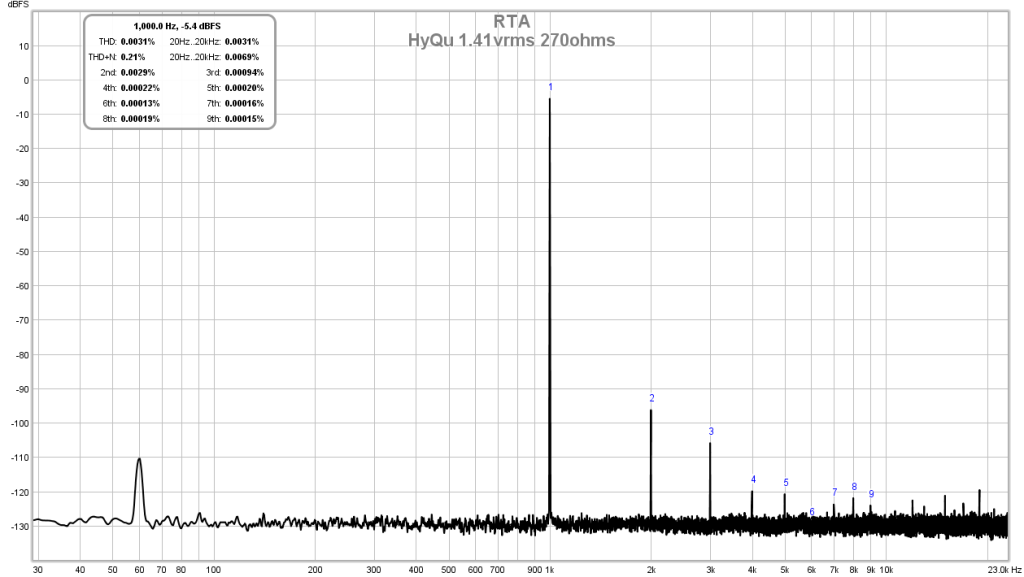
Amp looks like this and the cap Mx is the thing mounted on heatsink in between the two amp boards:
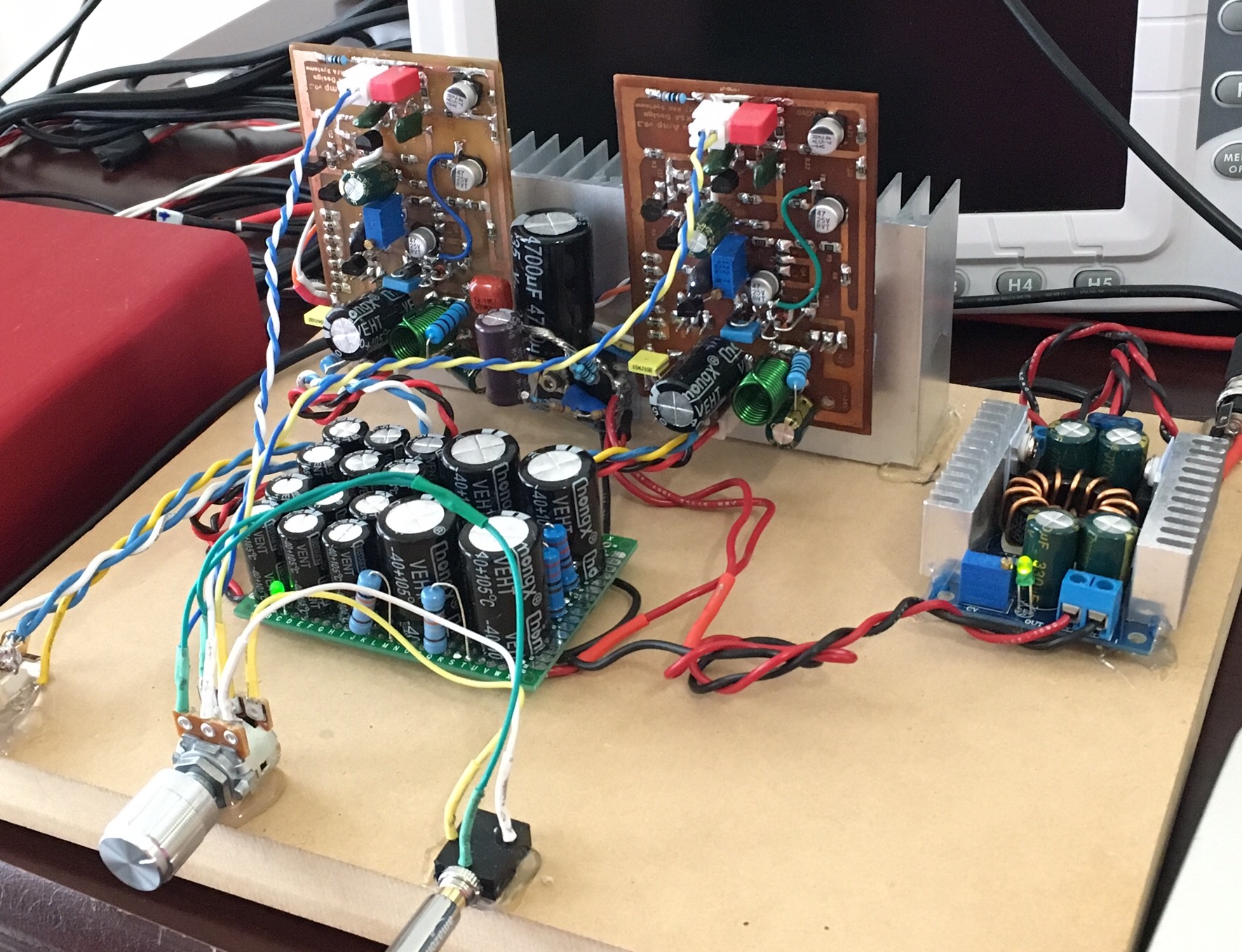
So this amp is currently in my office and paired with DT880-250's for my "work headphones".
From Post #1027 in this thread:
Amp looks like this and the cap Mx is the thing mounted on heatsink in between the two amp boards:
So this amp is currently in my office and paired with DT880-250's for my "work headphones".
my order from elecrow just arrived, ordered 10x of each board, but received 22 of the load share and almost 40 of the cap Mx board - if anyone in Aus wants a set of the boards happy to send for the cost of postage - pm me.
Would recommend elecrow $5 for an order of 10 PCBs and ~$5 for shipping. (and receiving way more lol
$5 for an order of 10 PCBs and ~$5 for shipping. (and receiving way more lol
Would recommend elecrow
Just poking my head in and I've made a slight modification to the layout.
Since I've cut the board trace right after the switch, I rewired everything so that the Load terminals on the load sharing charger board go into the switch directly instead of through the boost converter first. After the cut I've inserted both the boost converter and the cap Mx board instead of just the cap Mx circuit. This should help reduce battery drain when the device is off (I was noticing about 0.1V off the battery voltage every week or two - probably due to the boost converter always being in the circuit and the datasheet lying about off-state power consumption.)
For a new simple diagram:
Battery/USB -> LSC Board -> Battery Terminals on PCA -> Trace Cut -> Boost Converter -> Cap Mx -> Back to other side of the trace cut and off to the PCA circuit.
I'm not sure why I didn't do this originally after I cut the trace, I guess I didn't think about it and had the wires in place for the pre-capmx model.
Anyways, definitely wire it this new way. As before, grounds are all connected together so it doesn't matter how they're hooked up.
Since I've cut the board trace right after the switch, I rewired everything so that the Load terminals on the load sharing charger board go into the switch directly instead of through the boost converter first. After the cut I've inserted both the boost converter and the cap Mx board instead of just the cap Mx circuit. This should help reduce battery drain when the device is off (I was noticing about 0.1V off the battery voltage every week or two - probably due to the boost converter always being in the circuit and the datasheet lying about off-state power consumption.)
For a new simple diagram:
Battery/USB -> LSC Board -> Battery Terminals on PCA -> Trace Cut -> Boost Converter -> Cap Mx -> Back to other side of the trace cut and off to the PCA circuit.
I'm not sure why I didn't do this originally after I cut the trace, I guess I didn't think about it and had the wires in place for the pre-capmx model.
Anyways, definitely wire it this new way. As before, grounds are all connected together so it doesn't matter how they're hooked up.
For a new simple diagram:
Battery/USB -> LSC Board -> Battery Terminals on PCA -> Trace Cut -> Boost Converter -> Cap Mx -> Back to other side of the trace cut and off to the PCA circuit.
Thanks for the update...will do. Good think I'm going at a snail's pace!
So I did a quick test fit with all three RL mod boards in the tin. Looks like there will be room left for up to four 10x20mm caps to add a power filter.
I am thinking 4 x 25V 1000uF with five 0.47R 1W resistors (X's recommended value) between/around them. So it would go RCRCRCRCR, correct?? That way the rail caps on the PCA become the final "C" in the filter? It would help a lot if somebody would kindly critique this idea. Is it overkill, or is more always better?
Attachments
- Home
- Group Buys
- xrk971 Pocket Class A Headamp GB
